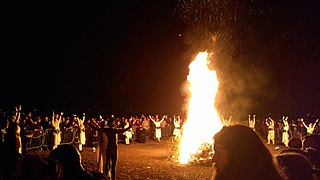
Beltane or Beltain is the Gaelic May Day festival. Most commonly it is held on 1 May, or about halfway between the spring equinox and summer solstice. Historically, it was widely observed throughout Ireland, Scotland, and the Isle of Man. In Irish the name for the festival day is Lá Bealtaine, in Scottish Gaelic Là Bealltainn and in Manx Gaelic Laa Boaltinn/Boaldyn. It is one of the four Gaelic seasonal festivals—along with Samhain, Imbolc and Lughnasadh—and is similar to the Welsh Calan Mai.
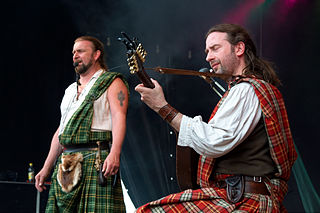
Celtic music is a broad grouping of music genres that evolved out of the folk music traditions of the Celtic people of Western Europe. It refers to both orally-transmitted traditional music and recorded music and the styles vary considerably to include everything from "trad" (traditional) music to a wide range of hybrids.
Samhain is a Gaelic festival marking the end of the harvest season and beginning of winter or "darker half" of the year. In the northern hemisphere, it is held on 1 November, but with celebrations beginning on the evening of 31 October, as the Celtic day began and ended at sunset. This is about halfway between the autumn equinox and winter solstice. It is one of the four Gaelic seasonal festivals, along with Imbolc, Beltaine and Lughnasa. Historically, it was widely observed throughout Ireland, Scotland, and the Isle of Man. A similar festival was held by the Brittonic Celts, called Calan Gaeaf in Wales, Kalan Gwav in Cornwall, and Kalan Goañv in Brittany.
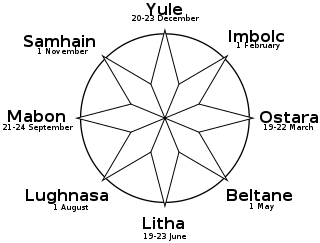
The Wheel of the Year is an annual cycle of seasonal festivals, observed by many modern Pagans, consisting of the year's chief solar events and the midpoints between them. While names for each festival vary among diverse pagan traditions, syncretic treatments often refer to the four solar events as "quarter days" and the four midpoint events as "cross-quarter days", particularly in Wicca. Differing sects of modern Paganism also vary regarding the precise timing of each celebration, based on distinctions such as lunar phase and geographic hemisphere.

Lughnasadh or Lughnasa is a Gaelic festival marking the beginning of the harvest season. Historically, it was widely observed throughout Ireland, Scotland and the Isle of Man. In Modern Irish it is called Lúnasa, in Scottish Gaelic: Lùnastal, and in Manx: Luanistyn. Traditionally it is held on 1 August, or about halfway between the summer solstice and autumn equinox. But, in recent centuries some of the celebrations shifted to the Sundays nearest this date.
In Celtic mythology, Carman or Carmun was a warrior and sorceress from Athens who tried to invade Ireland in the days of the Tuatha Dé Danann, along with her three sons, Dub ("black"), Dother ("evil") and Dian ("violence"). She used her magical powers to destroy all the fruit of Ireland.
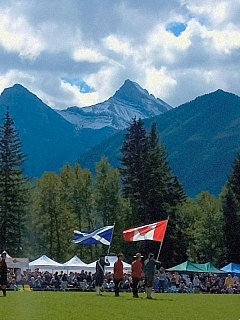
Highland games are events held in spring and summer in Scotland and other countries with a large Scottish diaspora, as a way of celebrating Scottish and Celtic culture, especially that of the Scottish Highlands. Certain aspects of the games are so well known as to have become emblematic of Scotland, such as the bagpipes, the kilt, and the heavy events, especially the caber toss. While centred on competitions in piping and drumming, dancing, and Scottish heavy athletics, the games also include entertainment and exhibits related to other aspects of Scottish and Gaelic cultures.

A mòd is a festival of Scottish Gaelic song, arts and culture. Historically, the Gaelic word mòd, which came from Old Norse mót, refers to any kind of assembly. There are both local mòds, and an annual national mòd, the Royal National Mòd. Mòds are run under the auspices of An Comunn Gàidhealach. The term comes from a Gaelic word for a parliament or congress in common use during the Lordship of the Isles.

The culture of Scotland refers to the patterns of human activity and symbolism associated with Scotland and the Scottish people. Some elements of Scottish culture, such as its separate national church, are protected in law, as agreed in the Treaty of Union and other instruments. The Scottish flag is blue with a white saltire, and represents the cross of Saint Andrew.

The Estádio Algarve is an association football stadium located between Faro and Loulé, in Portugal. It was the former home of Farense and Louletano, having received some Olhanense and Portimonense matches during their respective stadiums' works of renovation. From 2004 to 2013, Louletano shared the stadium with Sporting Clube Farense.
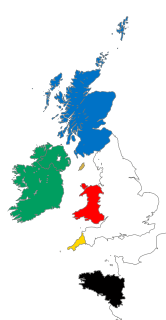
The Celtic nations is a cultural region and collection of geographical territories in Western Europe and the North Atlantic where Celtic languages and cultural traits have survived. The term nation is used in its original sense to mean a people who share a common identity and culture and are identified with a traditional territory.
The Saint Mungo Cup was a one-off football tournament held in Glasgow, Scotland, to celebrate the 1951 Festival of Britain. The competition was contested by fourteen 'Scottish Division A' clubs together with Clyde and Queens Park from 'Division B'. Celtic defeated Aberdeen 3–2 in the final in front of a crowd of 81,000 at Hampden Park.
Celtic Colours International Festival is a Celtic music festival held annually in October in communities all over Cape Breton Island in Nova Scotia, Canada. First held in 1997, the festival has featured hundreds of musicians from all over the Celtic world and attracted tens of thousands of visitors to Cape Breton Island. For nine days in October, Cape Breton Island is home to a unique celebration of music and culture as the Celtic Colours International Festival presents dozens of concerts all over the island, an extensive line-up of workshops, a visual art series of exhibitions, and a nightly Festival Club. Over the years, artists have traveled from Scotland, Ireland, Wales, England, Brittany, Spain, Denmark, Germany, Norway, Cuba, and Sweden as well as from across the United States and Canada.

Ortigueira, a seaport and borough in County Ferrolterra in Galicia, celebrates its patron saint day -Saint Martha of Ortigueira's Day- on 29 July.

The Mid-Maryland Celtic Festival is a one-day festival celebrating all things Scottish, held annually in Mt. Airy, Maryland, United States.
AberFest is a Celtic cultural festival celebrating all things Cornish and Breton that takes place every second year in Cornwall, UK, around Easter. The AberFest Festival alternates with the Breizh – Kernow Festival which is held in Brandivy or Bignan in Brittany, alternating between those two Breton locations.

The Pan Celtic Festival is a Celtic-language music festival held annually in the week following Easter, since its inauguration in 1971. The first Pan Celtic Festival took place in Killarney, County Kerry, Ireland. Its aim is to promote the modern Celtic languages and cultures and artists from all six Celtic nations: Brittany, Cornwall, Ireland, Isle of Man, Scotland and Wales.

Isle of Skye (Broadford) Airfield is a small airfield on the Isle of Skye, Scotland, with a single runway. It is next to the hamlet of Ashaig, near the village of Broadford.

The Celtic Media Festival, formerly known as the Celtic Film and Television Festival, aims to promote the languages and cultures of the Celtic nations in film, on television, radio and new media. The festival is an annual three-day celebration of broadcasting and film from Scotland, Ireland, Wales, Isle of Man, Cornwall and Brittany. The festival was founded in 1980.












